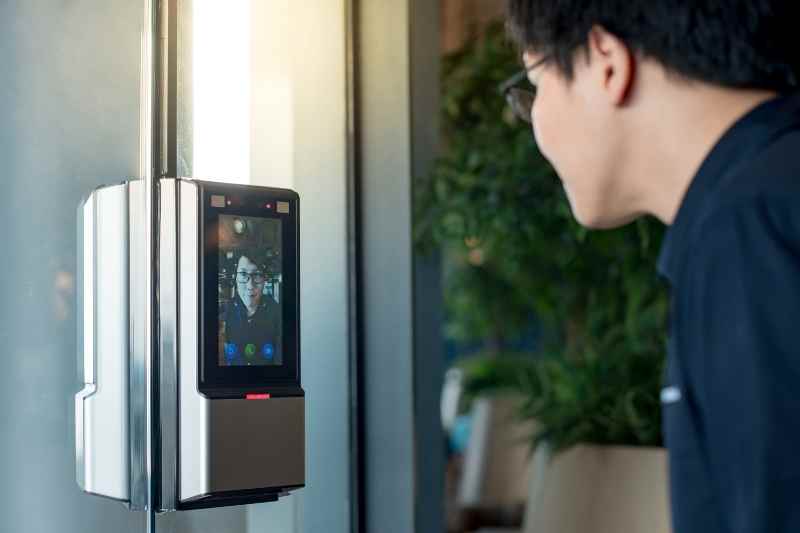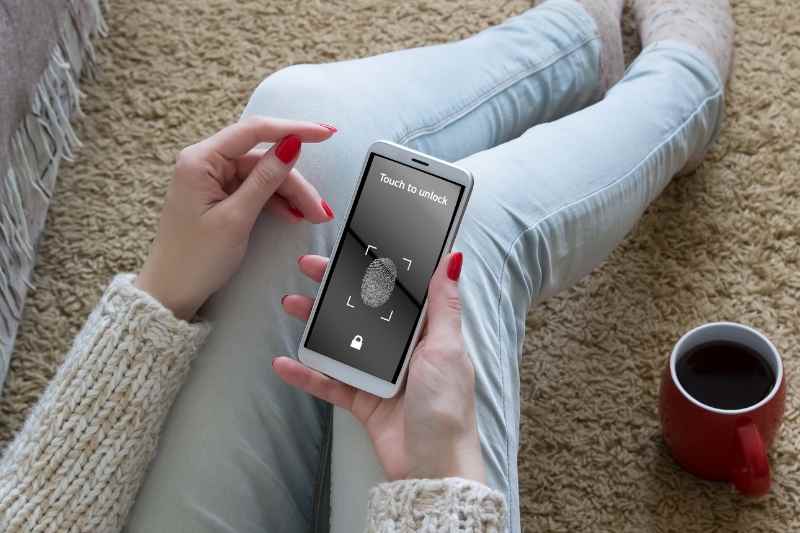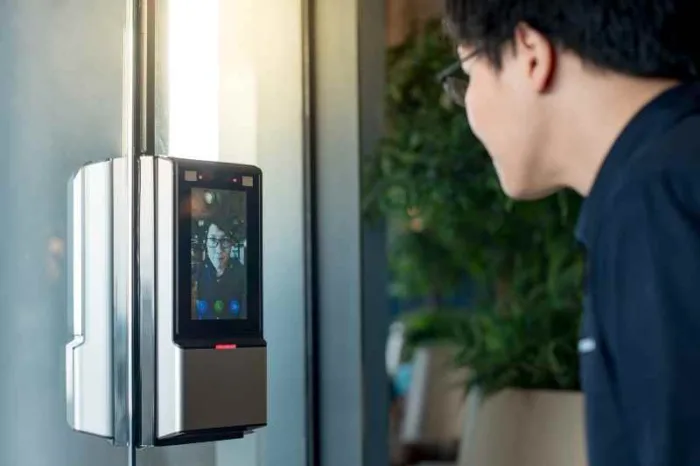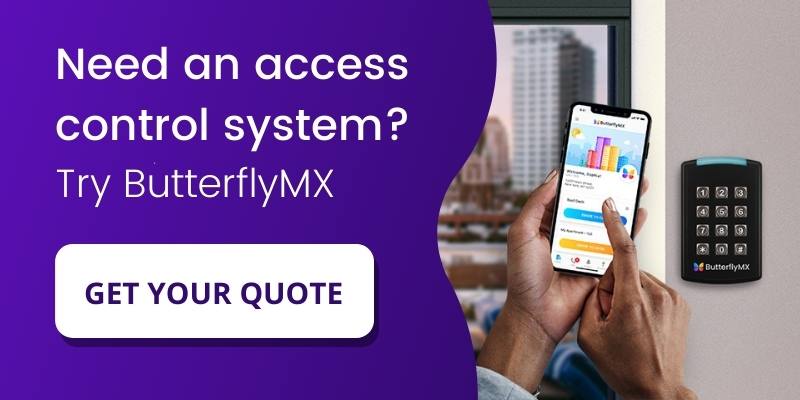Key takeaways
- Biometric access control is a common system that relies on unique biologic identifiers to grant entry into buildings and secure areas.
- Its main purpose is to use physiological features to determine if the user is allowed access. Additionally, it’s secure because it relies on individual data that is nearly impossible to duplicate.
- The top biometric access control types are fingerprint access systems, palm reading technology, iris scanners, facial recognition, and voice authentication.
- Biometric readers are safe and secure, especially when reinforced with biometric data encryption.

Biometric access control systems may sound like something from a science fiction show. But the truth is that it’s as accessible and mundane as the facial recognition and fingerprint reader on your smartphone or tablet.
In the last several years, it’s become second nature, as well as a secure method of controlling property access. But what exactly are biometric access control systems, and how do they work?
In this post, we’ll dispel some of the mysteries surrounding biometric security.
In this post, we cover:
- What is the purpose of biometric access control?
- The 5 main types of biometric access control systems
- Costs and installation
- Cases of biometric access control use
- Pros and cons of biometric access control
- Overall safety of biometric access control
What is the purpose of biometric access control?
Essentially, the purpose of biometric access control is to control who can enter a space by verifying a person’s identity using unique physical identifiers. Because the user is the only one with these unique features, the biometric access system can only be open to those who match these requirements.
Additionally, this kind of access system makes it easy for people to enter buildings without toting around a key or memorizing passcodes.
How does biometric access control work?
Biometric access control systems are a great way to guarantee secure access with elevated accuracy and reliability.
But how do these systems work?
A biometric access control system is comprised of these key components:
- Biometric reader. The reader scans a biometric credential, like your fingerprint, palm, iris, or face, to grant access.
- Door controller. Door controllers power the door and communicate with the reader when a valid access credential is scanned.
- Electronic or wireless locks. Electronic door locks are designed to release and grant access to users when a valid credential is read.
- Access control software. Biometric access control software empowers you to manage, monitor, and control who accesses your property.
Discover the differences between electric and magnetic locks:
The 5 main types of biometric access control systems
There are many different variations of the biometric access control system. But only a few of them are in regular use.
The five main types of biometric access include:
1. Fingerprint access
You likely grew up learning about the singularity of your fingerprints and how there are no duplicates. That’s why fingerprint access control technology is one of the most reliable and secure.
It’s also a very easy technology to use, making access simple and secure. Setting up fingerprint entry is fast — you only have to let the reader scan your fingerprints from varying angles as it stores the data in the system for future use.
This type of system, including biometric deadbolts and door locks, is generally used in commercial buildings but is also found at some residential properties.

2. Palm reader technology
It’s easy to get palm reading technology mixed up with fingerprint recognition. However, palm reading devices go deeper than the surface.
A palm reader uses infrared scanning technology to read the veins and patterns below the skin. This type of biometric technology is secure because vein patterns are unique to each person’s genetic makeup — they also never change.
3. Iris scanners
Perhaps most frequently seen in futuristic media, the iris scanner isn’t as fictional as it seems. Iris scanners are very common in high-security areas because they are much more difficult to duplicate.
Most people want to know, “Is iris scanning accurate and, is it safe?” The accuracy of an iris scan is about 90% to 99%, making it very reliable. As for the safety of this technology, the exposure to infrared is so small there’s little chance for health concerns.
4. Facial recognition
Facial recognition technology is perhaps the most common after fingerprints. Not only is it easy, but it’s also very effective. Facial recognition is one of the most common access control methods for smartphones, but you may also find it in building access.
For those who are proponents of touch-free access control options, this would be a great choice. It’s convenient and doesn’t require punching in passcodes or carrying key cards and fobs to unlock.
5. Voice authentication
Most people wouldn’t think about voice authentication as a biometric reader, but it definitely deserves a spot on the list. While voices aren’t listed as imitation-proof, they are still an effective biometric access system.
The reason voice authentication is still valid is that it’s yet another form of touchless access control. Letting residents use their voices to streamline access to the building is convenient and secure.
To use voice authentication, users only have to repeat prompts like “car” or “home,” so the system learns their pitch, volume, and tone — which makes accessing a building with your voice fast and effortless.
Costs and installation
The cost of biometric access control systems can range from $2,500 to $10,000 per door because of the costs associated with purchasing biometric scanners, electronic locking mechanisms, software, and installation costs.
In addition, hiring a certified technician or installer is necessary for any biometric access control system due to the complexity of the technology.
Cases of biometric access control use
Biometric access control can be hard to conceptualize, even though it’s more common than people think.
Instances where you might use biometric access control:
- Smart devices: You use biometric access almost every day when accessing your smart devices. When you let your phone scan your face or fingers to unlock the device, you give it permission to use your physiological features in place of a password.
- High-security areas: Some organizations prefer to use recognition technologies such as fingerprint and facial recognition because these are difficult to fake. You may also have some agencies that use facial recognition surveillance in garages and parking areas.
- Healthcare facilities: Biometric access control is beneficial for healthcare facilities because it limits the need for touching, which can easily spread germs in a high-risk environment. Additionally, touchless access in these buildings makes entry quick and easy.
Pros and cons of biometric access control
While biometric access control systems offer numerous advantages, there are some potential drawbacks and concerns to be aware of.
What are the advantages of biometric access control?
- Enhanced security. Biometric access credentials can’t be stolen, loaned, or cloned in the same ways traditional keys can.
- Automatic access. Biometric readers automatically scan bodily credentials for quick, easy, and convenient access to buildings.
- Reliable. Biometric authentication is fast and allows authorized individuals to accurately and reliably access secure areas quickly and efficiently.
- Integrations. Biometric systems are a comprehensive security solution because they can be integrated with other security systems, like surveillance cameras and alarms.
What are the drawbacks of biometric access?
- Pricey. Biometric systems can be expensive because of costs related to hardware, software, installation, and integration with existing systems.
- Requires routine maintenance. Biometric systems require quarterly or semi-annual maintenance, as well as software updates, to ensure optimal performance.
- Can have limited scalability. Some biometric systems might face limitations in scalability, especially when dealing with a large number of users.
Overall safety of biometric access control
The safety and privacy of the user is the first concern on people’s minds when discussing biometric readers. You’ve likely seen the discussions in light of these technologies being advanced throughout industries.
The bottom line is that, while concerns are valid, biometric technology can be safe and secure for everyone involved. Additionally, the authentication aspect of these systems balances both security and convenience.
In general, biometric technology tends to become stronger with use. This ensures that, with time, the possibility of being hacked is less applicable. However, that security depends heavily on the successful encryption of data.








